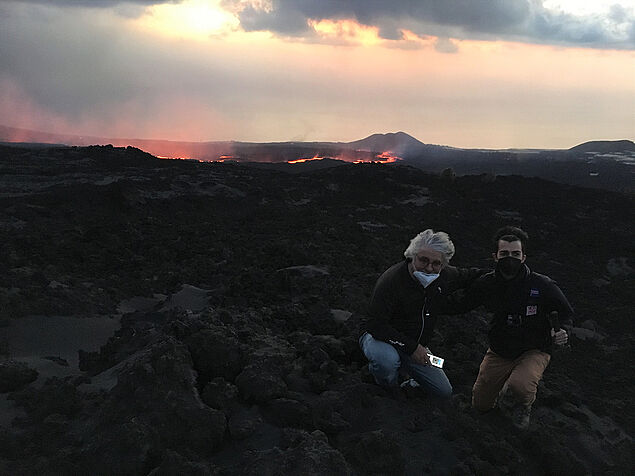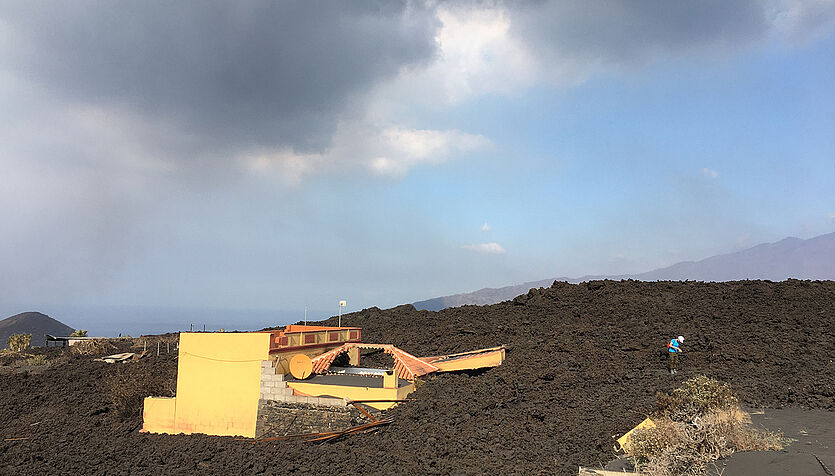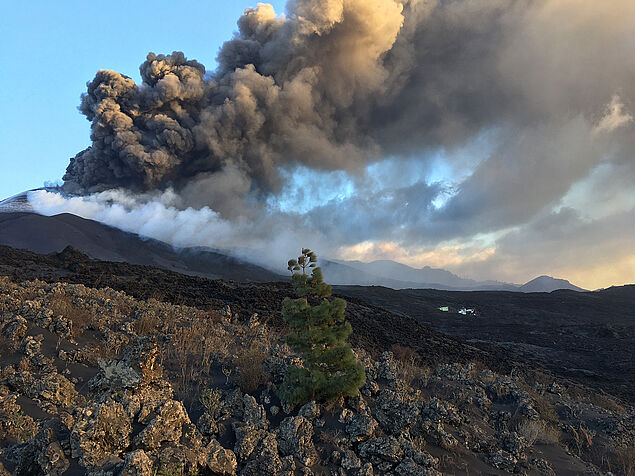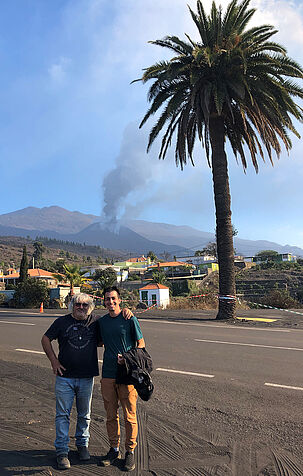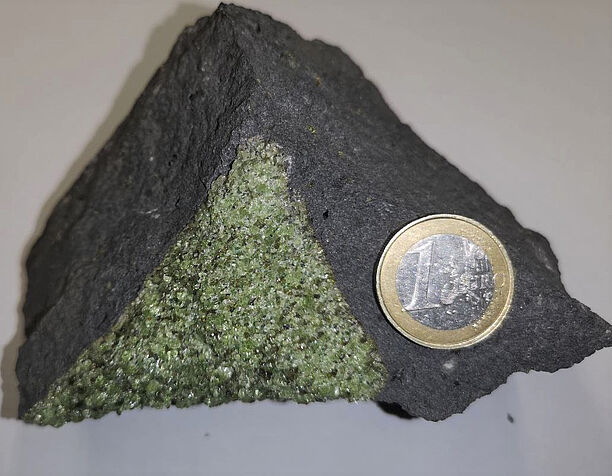Sampling hot lavas on active volcanoes: the 2021 eruption at La Palma island
23.11.2021
Studying the volatiles distribution from the mantle to the surface: Theodoros Ntaflos and Federico Casetta from the Department of Lithospheric Research are analysing the 2021 eruption of Cumbre Vieja volcano (La Palma, Canary Islands).
After 50 years of quiescence, on September 19th 2021 the Cumbre Vieja volcano in La Palma (Canary Islands) erupted, emitting more than 200-300 million m3 of lava and ash, and releasing huge amounts of gases (up to 50000 tons/day) in the atmosphere.
This eruption is deeply threatening the island of La Palma and its economy, destroying hundreds of houses and inducing the evacuations of more than 6000 people. Despite the awareness of the scientific community about the continuous activity of the Canary Islands volcanoes - last eruptions occurred in 1909 at Teide, in 1971 at La Palma, and in 2011-2012 at El Hierro - several questions about the onset of these eruptions and the evolution of the volcanism in the archipelago are still pending.
Origin and role of volatiles
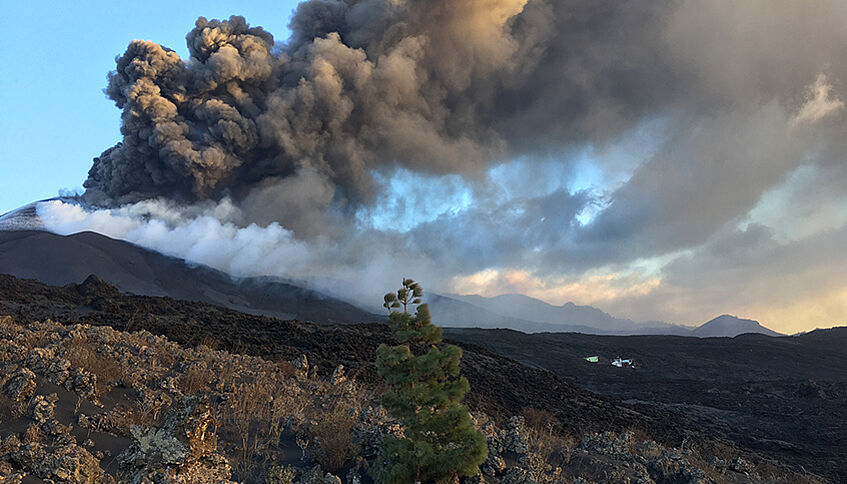

Fotos: © Theodoros Ntaflos, Federico Casetta / Universität Wien
Among these, hotly debated is the origin and role of volatiles (i.e. H, N, NH3, CH4, H2O, CO2, and SO2) during the genesis of magma at depth in the Earth’s mantle and its ascent towards the surface, ultimately resulting in eruption of variable intensity.For this reason, linking the volatiles cycle within the deep Earth portions to the gaseous emissions from volcanoes is the next frontier of geodynamics and volcano monitoring, being crucial to understand both the long-term evolution of magmatic systems and the short-term variations associated to volcanic unrests.
A team of researchers composed by Theodoros Ntaflos and Federico Casetta (University of Vienna), Andrea Rizzo (INGV – Section of Palermo) and Andres Sandoval Velasquez (University of Palermo) organized a sampling campaign focused on the study of the current eruption at La Palma, in collaboration with colleagues from the INVOLCAN-ITER centre of Canary Islands.
The researchers accessed and sampled the cooling lava flow extruded from Cumbre Vieja, as well as several mantle-derived xenoliths brought to the surface by magmas in La Palma island during the last hundred thousand years. Their aim is to study the chemistry of the crystals, and also the composition of the volatiles entrapped therein in the form of “fluid inclusions”.
“As we try to capture different snapshots of the evolution of the volcanism in La Palma, it is important to collect samples from the ongoing eruption but also from older (historical and pre-historical) events,” explains Theodoros Ntaflos from the Department of Lithospheric Research. “The integrated application of petrology, thermodynamic modelling, geospeedometry, fluid inclusions and gas geochemistry is an efficient way for exploring the evolution of Earth, and opens new perspectives on a better comprehension of the genetic causes of mantle processes and volcanic phenomena,” he explains.
The scientists, in fact, will try to link the concentration and signature of volatiles measured in mineral-hosted fluid inclusions to the chemical-physical conditions recorded by the crystals, and thus to the main processes occurring in between the mantle and the Cumbre Vieja volcano.
“Our goal is to achieve a comprehensive picture of the volatiles cycle within the Canary lithosphere. To do that, we want to understand which kind of processes are recorded in the mantle beneath La Palma, in terms of partial melting, metasomatic processes, and thermal-redox conditions,” says Federico Casetta, researcher at the Department of the University of Vienna. Afterwards, the researchers “try to link the million-years long history of the mantle to the short-term dynamics associated to the volcanic unrest, such as magma ascent, degassing, ponding and mixing,” he explains.
From the depths of the mantle to the surface
The diffuse distribution of some chemical elements in the minerals of a magma makes it possible to determine the time it takes to reach the Earth’s surface from the depths, and hence being erupted either effusively or explosively. “In addition, the study of the diffusion processes makes it possible to determine the depth from which the lava originates and to calculate the dwell time of the magma at a certain depth before an eruption,” says the lithospheric researcher Ntaflos.
Connecting the processes taking place in the deep portions of Earth to those observed at the surface can help in developing interpretative models, improving the monitoring protocols in active volcanic contexts, and hence implementing our ability to forecast eruptions, Ntaflos explains: “The samples that petrologists collected at Cumbre Vieja will be extremely important in this respect, as they contain huge amount of both crystals grown within the magma (phenocrysts) and fragment of crystals from the deep crust and mantle (xenocrysts).”
From the morphological point of view, the still cooling lava flows is composed of a top portion that is slightly scoriaceous, and by an internal massive part, richer in mm-sized phenocrysts of olivine and pyroxene and mm- to cm-sized bubbles. Occasionally, larger olivine xenocrysts are observed, together with fragment of rocks deriving from the deep crust, or maybe the mantle.
Xenoliths: Mantle-derived stones
Mantle xenoliths (from the Greek xeno = “foreign” + lithos = “stone”) enable us to study and understand the evolution of the otherwise inaccessible Earth Mantle. Their relative rapid transport to the surface prevents any significant physicochemical change and provide us important information about the conditions (Pressure, Temperature chemical composition) that occur in depths up to 240 km.
Photo: Example of a mantle xenolith entrained by massive lava. © Theodoros Ntaflos, Federico Casetta / Universität Wien
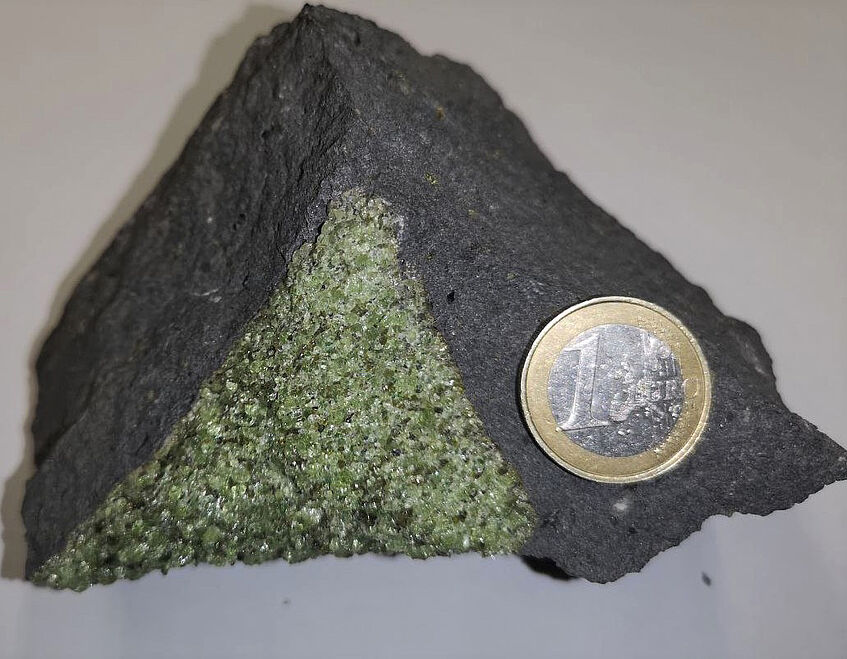
In the next weeks, the scientists will study the collected rocks intensively – “thanks to the state-of-the-art analytical techniques available at the Department of Lithospheric Research of the UniVIE,” says Casetta: “So we hope to be able to report new insights on the main forces driving the Cumbre Vieja eruption, from the mantle to the surface soon!”

